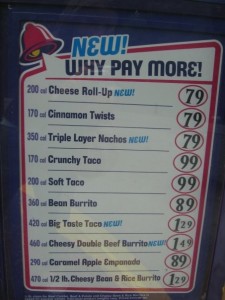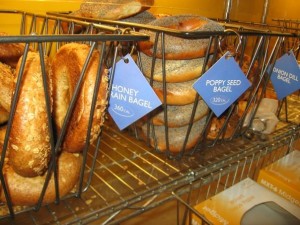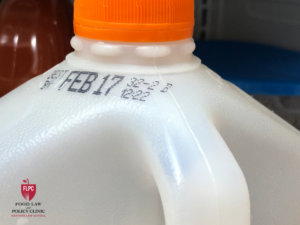by Alicia Lee (JD ’16)
 On Dec. 1, 2014, the Food and Drug Administration (FDA) published two final rules implementing the nutrition labeling provisions of the Patient Protection and Affordable Care Act (PPACA) §4205. Both rules can now be found on the Federal Register: (1) for restaurants and retail food establishments (SRFEs) and (2) for vending machines.
On Dec. 1, 2014, the Food and Drug Administration (FDA) published two final rules implementing the nutrition labeling provisions of the Patient Protection and Affordable Care Act (PPACA) §4205. Both rules can now be found on the Federal Register: (1) for restaurants and retail food establishments (SRFEs) and (2) for vending machines.
Background and Purpose of the Rules
As part of the federal effort to address the growing problem of obesity, §4205 of the PPACA established nutrition labeling requirements to inform consumers about the foods they were eating and to help them track daily calories. Although the requirements of §4205 went into effect when the PPACA was signed on March 23, 2010, the Act required FDA to promulgate regulations for the following: (1) standards to determine and disclose the nutrient content for standard menu items that are listed as a single menu item but come in different flavors, varieties, or combinations, (2) any other nutrient that may be helpful for healthy diets, (3) rules for registration of establishments that are not mandated to comply with the requirements but decide to voluntarily provide nutrition information, (4) the manner of the nutrient content disclosure, and (5) a statement on the menu or menu board explaining the recommended total daily calorie intake. The FDA also had the task of establishing the scope of SRFEs, since they were not defined in the PPACA.
FDA published its proposed rule in the Federal Register on April 6, 2011. The public comment period for the proposed rule ended on July 5, 2011. For more than three years, issuance of the final rule was delayed as FDA reviewed the comments and the Office of Management and Budget reviewed the final rule. Considering the long delay and the continuing rise of obesity and other food-related chronic diseases, the release of the final rule is a welcome development.
Major Provisions of the Rules
In response to the public’s comments, the final rule adopts a broad definition of restaurants and SRFEs: “a retail establishment that offers for sale restaurant-type food.” The rule defines restaurant-type food as food that is “usually eaten on the premises” or immediately after its purchase and either sold in restaurants or prepared and sold in similar retail establishments. Under the rule, the following establishments would be covered and subject to the nutrition labeling requirements: “bakeries, cafeterias, coffee shops, convenience stores, delicatessens, food service facilities located within entertainment venues (such as amusement parks, bowling alleys, and movie theatres), food service vendors (e.g., ice cream shops and mall cookie counters), food take-out and/or delivery establishments (such as pizza take-out and delivery establishments), grocery stores, retail confectionary stores, superstores, quick service restaurants, and table service restaurants.”
The inclusion of grocery stores in the definition of SRFEs is a big win for proponents of expansive nutrition labeling. The grocery industry and other industry groups, such as the Food Marketing Institute, have raised several challenges against subjecting grocery and convenience stores to the nutrition label requirements. The FDA addresses these arguments in the final rule, and refers to Congressional intent as shown by the legislative history of PPACA §4205 to support its decision. The final rule also covers many items that were potentially subject to exemption under the proposed rule. Calories for variable menu items (ie: soft drinks, donuts, or ice-cream that have multiple flavors) must be listed for each item or be given a range. The same applies to combination meals.
Alcohol is another win for nutrition labeling advocates. While the proposed rule suggested a general exemption for alcohol, the final rule requires calorie information for alcoholic beverages that are standard menu items. The rule does exempt, however, alcoholic beverages that are “on display and not self-service food (e.g., bottles of liquor behind the bar used to prepare mixed drinks)” from the labeling requirements for foods on display.
There are still a number of exemptions for other items as well, including condiments, daily specials, and temporary menu items. Furthermore, while grocery stores are covered under the final rule, the rule only applies to foods that are restaurant-type foods. Exempt foods include items that are sold in bulk bins (e.g., dried fruits and nuts), foods not intended to be consumed in one sitting (e.g., loaves of bread), and foods sold by weight that are not self-serve and not intended for individual consumption (e.g., deli salads like chicken or potato salad).
 Critique of the Rules and Calorie Labeling in General
Critique of the Rules and Calorie Labeling in General
Having read about the contentious development of the proposed rules, I was quite satisfied to see the results in the final rule. The final rule covers a lot more ground than suggested in the proposed rule, which speaks to the government’s recognition that consumer awareness is critical to empower people to make healthier choices.
Of course, the fact that the rule is limited to “restaurants and similar retail food establishments that are part of a chain with 20 or more locations” excludes a lot of restaurants, grocery stores, and other establishments. However, this provision was part of the PPACA §4205, and FDA would not have been able to change it in its final rule.
Despite the progress of the final rule, it still remains to be seen whether the availability of calorie information will successfully encourage consumers to choose healthier options. There is conflicting research regarding the effects of calorie labeling. While some studies have shown that calorie labeling can influence selection of lower-calorie menu options, others have shown that consumers either did not notice the labels or bought the same foods despite the calorie postings.
Even if consumers did choose lower calorie options due to calorie labeling, the benefits of their choices might be negated by the phenomenon of “compensation.” Research shows that people who have limited calories earlier in the day will often compensate for them later by eating more for lunch or dinner. By knowing exactly how many calories were saved by a certain food choice, consumers may feel more justified to eat a cookie or more food later, counteracting the health benefits of their earlier decision.
This is especially problematic considering that calorie postings by restaurants and food manufacturers have been far from reliable. Experiments with food items sold in restaurant chains and grocery stores that have posted calorie information show that the calorie information is often grossly underestimated. In one case, a vegan, purportedly low-calorie sandwich that was labeled as having 228 calories had in fact 548.4 calories—more than twice the declared value. In the final rule, FDA “decline[d] to include such a protocol for checking the accuracy of the nutritional information,” until after it had the opportunity to “evaluat[e] compliance with the rule.”
Including calories on menu and menu boards may even have the undesired effect of encouraging people to buy unhealthy options. A New York health-policy researcher found that after New York’s labeling laws went into effect, people in low-income communities bought more calories at fast food restaurants. Since their “priority [was] getting the most food for the fewest dollars,” they chose the meals with the highest number of calories. Already, low-income communities have a higher prevalence of obesity. If calorie labeling proves to encourage even more unhealthy eating behavior in low-income communities, the final rule will fail to make a positive difference where it is most needed.
Furthermore, focusing on calories may perpetuate the misconception that a low-calorie diet is necessarily a healthy diet. Many leading researchers of diet and obesity have argued that not all calories are created equal. Making only caloric information visible to consumers effectively places all foods on one scale where they are different only in terms of calories. Thus, consumers could receive the mistaken idea that 100 calories worth of French fries will have the same effect on weight and health as 100 calories worth of fresh fruit.
Perhaps labeling sugar rather than calories might be more effective in improving public health. In the Food Law and Policy Seminar at HLS, we have discussed the excessive consumption of sugar in the U.S. extensively. As a side note, I *almost* bought a can of cranapple juice at the store yesterday. It was a typical can (11.5 fl. oz.) and had 220 calories. What really shocked, me, though, was the sugar content: 58g! I then realized that I did not even know how to interpret this information, and it occurred to me that there is no % Daily Value next to sugar. For other nutrients like fat and sodium, we can gauge how much we are consuming based on the %DVs, but we cannot do the same for sugar.
The final rule suggests that menu and menu boards state the following: “2,000 calories a day is used for general nutrition advice, but calorie needs vary.” I wish there were a similar emphasis on (or simply more information regarding) the recommended sugar intake. I had to do a google search to find that the American Heart Association advises that men should consume no more than 37.5g added sugars per day while women should consume no more than 25g per day. This makes me really glad that I chose not to get that cranapple juice!
The focus on calories likely misses the actual reasons behind chronic diseases. It furthers the misconception that a calorie is just a calorie, and that being overweight equals being unhealthy. The real cause of chronic diseases like diabetes, cardiovascular disease, and hypertension, however, is not excess consumption of calories, but excess consumption of sugar and potentially sodium. Perhaps calories are the simplest way to educate people about their food choices. I hope that eventually, though, we can get to a point where we give the actual culprits center stage in the efforts to improve public health.
————–
The views reflected in this blog are those of the individual authors and do not necessarily represent those of the Center for Health Law & Policy Innovation or Harvard Law School. This blog is solely informational in nature, and not intended as a substitute for competent legal advice from a licensed and retained attorney in your state or country.


Health Law & Policy, Commentary
Medicaid Section 1115 Waivers for Reentry: Updates and Resources – Health Care in Motion
April 17, 2024